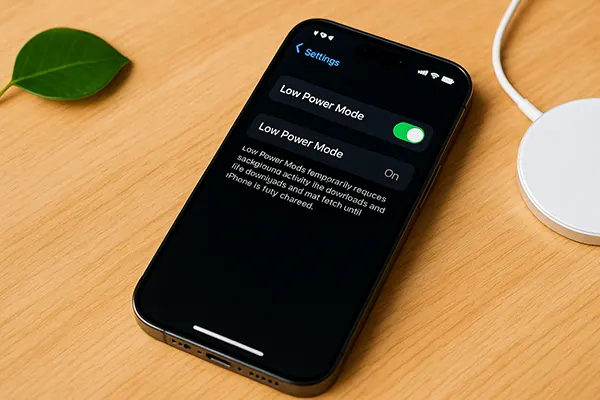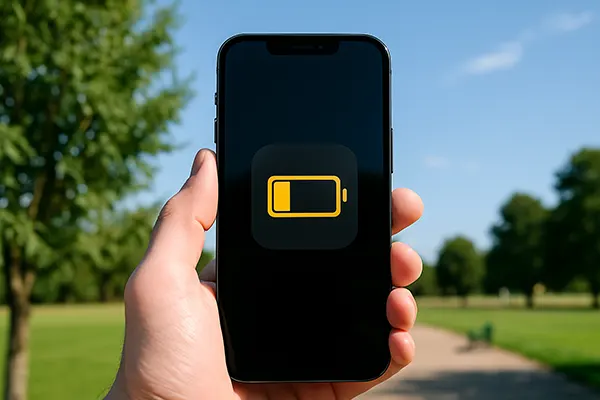Low Power Mode in iPhone 15 Pro Max: Real Efficiency, Hacks, and Limitations

The iPhone 15 Pro Max continues Apple’s legacy of top-tier performance with advanced hardware, but like all smartphones, it faces battery consumption challenges. With the device now supporting more energy-demanding tasks—from high-frame video capture to gaming on the A17 Pro chip—users frequently rely on Low Power Mode to extend daily usability. This article explores practical insights about how this feature works, how efficient it is in 2025, and what trade-offs users need to be aware of.
Real Battery Gains from Low Power Mode
Low Power Mode has matured significantly since its introduction, and the iPhone 15 Pro Max now leverages it with tighter integration into iOS 17.6. Once activated—either manually or automatically at 20%—the mode limits background activity, reduces visual effects, throttles CPU performance slightly, and pauses automatic downloads. In practice, this can offer up to 2.5 extra hours of screen-on time depending on usage.
Tests conducted in 2025 show that users engaging in mixed usage (social media, browsing, camera use) can stretch their battery life from 10–11 hours up to 13 hours with Low Power Mode activated continuously. The efficiency boost is particularly notable when location services, 5G, or ProMotion 120Hz display features are restricted.
Gamers and content creators may notice slightly reduced performance, but for daily use like texting, calling, or even short video watching, Low Power Mode maintains a near-identical experience without visual degradation. It’s an ideal feature for travel days or situations when charging isn’t available.
System Optimisations Enabled in Low Power Mode
When activated, Low Power Mode modifies several system-level behaviours. Firstly, the A17 Pro chip reduces peak clock frequency by up to 40%, prioritising energy efficiency over speed. This change isn’t noticeable in basic operations but helps avoid battery drain in idle states. Secondly, background app refresh is suspended entirely, preventing unnecessary data syncing.
Another major change is to mail fetching intervals, which switch from “push” to “manual” or hourly checks. This helps users avoid battery drain from real-time email syncing. Moreover, automatic app updates and iCloud Photos syncing pause temporarily, ensuring that large background processes don’t trigger on mobile data or while the device is idle in your pocket.
Finally, animations and motion effects are reduced, including those linked to dynamic island elements and weather effects in system apps. These small changes contribute significantly to extending uptime across the day without reducing usability or clarity.
Helpful Hacks to Maximise Efficiency
Many iPhone 15 Pro Max users have developed habits and tricks to extend battery life even further while in Low Power Mode. One such strategy is scheduling the mode using Shortcuts Automation. Users can create triggers based on battery percentage, time of day, or even app activity to automate activation and deactivation of the mode without user input.
Additionally, turning off location services for non-essential apps, switching off ProMotion by limiting the display to 60Hz, and manually reducing screen brightness further help conserve energy. While these steps go beyond what Low Power Mode adjusts automatically, they’re particularly useful when combined with it during extended outings or travel.
Another commonly used method is enabling Focus Mode with Do Not Disturb, which reduces the number of notifications waking the screen. Since screen wake-ups are among the top sources of battery drain, this trick alone can save up to 10% battery throughout the day. Moreover, offline usage of music or maps (by downloading content) significantly helps reduce background data use, improving battery reliability in offline scenarios.
Hidden iOS Settings Worth Adjusting
One hidden gem is the option to disable “Live Activities” from the Settings app under Face ID & Attention. Live Activities, especially those tied to sports, deliveries, and timers, run persistently and consume more power when left unchecked—even in Low Power Mode. Turning them off reduces drain considerably.
Users can also navigate to Accessibility → Motion and enable “Reduce Motion.” This setting is independent of Low Power Mode but complements it perfectly, as it disables parallax and unnecessary animations. Combined with Low Power Mode, the user interface feels slightly more static but noticeably more efficient.
Finally, disabling “Hey Siri” voice detection removes the need for the device to continuously monitor ambient sound. Users who seldom use voice commands gain both privacy and battery savings by turning this setting off—especially valuable during long offline trips.

Known Limitations and When to Avoid Using It
Despite its benefits, Low Power Mode does come with some trade-offs. Most significantly, 5G performance is slightly reduced, and in some regions, the device may fall back to LTE to conserve power. While this isn’t an issue for casual browsing or messaging, it may impact users relying on fast cloud uploads or real-time video calls.
Another limitation is background syncing. Apps like Google Photos, WhatsApp backups, or even Apple’s own Photos app will delay or entirely skip syncing processes until the mode is disabled. For users who frequently capture large media files, this delay may hinder real-time access to cloud content across multiple devices.
Additionally, performance-heavy apps like Adobe Lightroom or mobile video editors experience reduced responsiveness under Low Power Mode. If you’re working on urgent tasks involving media rendering or editing, it’s recommended to deactivate the mode temporarily to unlock full performance capabilities.
When Low Power Mode May Not Be Ideal
For professional use, such as mobile video conferencing or running developer simulations, Low Power Mode may not be the best companion. The throttled CPU frequency and limited network activity might cause app stuttering or syncing issues. In such cases, it’s better to ensure charging access and keep the mode off.
Low Power Mode also affects GPS-based apps such as turn-by-turn navigation or fitness trackers. Since the system deprioritises background location updates, route tracking may become inconsistent. Users depending on precise GPS—for hiking or cycling—should avoid enabling the mode during active navigation.
Lastly, those using widgets that depend on real-time data (weather, stocks, smart home dashboards) will notice delayed updates. While the iPhone 15 Pro Max is still responsive, the information displayed might lag by several minutes, impacting the user experience for power users or professionals.
